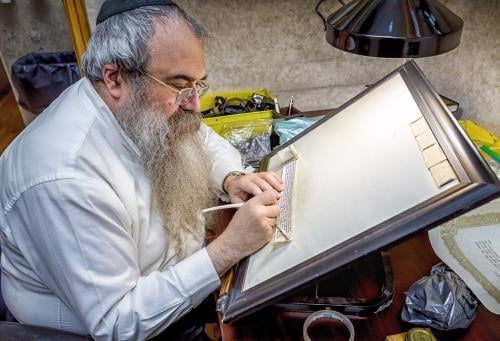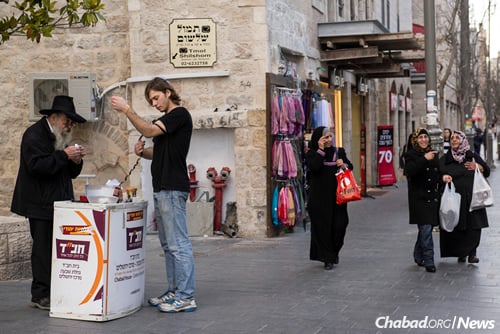Tefillin (תְּפִלִּין) are a pair of black leather boxes containing Hebrew parchment scrolls. A set includes two—one for the head and one for the arm. Each consists of three main components: the scrolls, the box and the strap.
They look like this:

The Torah commands Jewish men to bind tefillin onto their head and upper arm every weekday, in fulfillment of the verse (Deut. 6:8), “You shall bind them as a sign upon your hand, and they shall be for a reminder between your eyes.” (More on what this means below.)
Tefillin is an incredibly powerful mitzvah. The experience of putting on tefillin has changed many people’s lives.
What’s in the Boxes?
The Torah mentions the mitzvah of tefillin four separate times. Each of these texts is inscribed on parchment and placed into the tefillin. These passages discuss the unity of G‑d. They describe the miracles G‑d performed for us when He took us out of Egypt, and how G‑d alone has the power and dominion to do whatever He wants in the physical and spiritual worlds. In other words, these verses cover the fundamentals of our faith.
These texts are:
1–2. Kadesh (Exodus 13:1–10) and Vehayah ki yeviacha (Exodus 13:11–16): These describe the duty of the Jewish people to always remember the redemption from Egyptian bondage, and the obligation of every Jew to educate his children about this and about G‑d’s commandments.
3. Shema (Deut. 6:4–9): Pronounces the unity of the one G‑d, and commands us to love and fear Him.
4. Vehayah (Deut. 11:13–21): Focuses on G‑d’s assurance to us of reward that will follow our observance of the Torah’s mitzvahs.

How Are Tefillin Made?
In order to be kosher according to Jewish law, tefillin must meet thousands of requirements. Think of them as a finely tuned spiritual machine. If one part is out of place, the whole thing won’t work.
The scrolls inside the tefillin are inscribed in black ink with a quill (or reed) pen by a specially trained scribe, known as a sofer. The parchment is handmade, and must be from a kosher animal. The scribe concentrates intensely and writes with special Hebrew characters. There are 1594 letters in each of the tefillin boxes. If one letter is extra, missing, or even incorrectly written, the tefillin are invalid.
The boxes and straps are also made of leather from a kosher animal. The head-tefillin is made of four separate compartments, each one containing a scroll with one of the four Torah selections. The hand-tefillin has just one chamber, with all selections written on a single scroll.
You’ll notice that the head tefillin has the Hebrew letter Shin (ש) on both sides, one with three branches, and the other with four.

Who Puts on Tefillin?
All Jewish males over the age of bar mitzvah (13 years old) should perform the mitzvah of tefillin.
When Are Tefillin Worn?
You can fulfill the mitzvah by putting on tefillin anytime during the day—from sunrise to nightfall. A blessing is recited, and it is customary to read the Shema prayer. Traditionally, tefillin are worn during weekday morning prayers.
Tefillin are not worn on Shabbat and major Jewish holidays (including Chol Hamoed, according to many).

Read: On Which Days Do We Not Wrap Tefillin?
How to Wear Tefillin
The hand-tefillin are strapped onto the left arm (or on the right arm, for a lefty), with the box resting on the bicep, facing the heart. The rest of the strap is then wound around the arm seven times, extending down to the long finger. There are many customs regarding how the coils are positioned on the arm and finger(s).
The head-tefillin are placed on the head like a crown, with the box resting just above the hairline in the center of the forehead.
Get step-by-step instructions for wrapping tefillin Chabad-style
The Meaning of Tefillin
Mitzvahs are commandments, but the word mitzvah also comes from the root tzavta, which means “connection.” A mitzvah creates a bond between G‑d who commands and man who performs. In a sense, that makes tefillin the ultimate mitzvah. We’re commanded to literally bind ourselves to the one and only G‑d.
More specifically, one of the boxes is placed on the arm so as to rest against the heart, the seat of the emotions, and the leather strap is wound around the left arm and hand. The other box is placed on the head, above the forehead. This teaches us to dedicate ourselves to the service of G‑d in all that we think, feel and do.
The Rebbe’s Tefillin Campaign
We read in the Talmud that once a Jewish male wears tefillin on his head—even one time in his life—he falls into a different category as a Jew.
Commenting on the verse (Deut. 28:10), “All the nations of the land will see that the name of G‑d is called upon you,” the sages declare that this refers to the head-tefillin.
Wearing tefillin is important not just for you as an individual; it brings protection to the Jewish people. This is why, just before the outbreak of the Six-Day War in 1967, the Rebbe—Rabbi Menachem M. Schneerson, of righteous memory—began a campaign to encourage Jewish men and boys to put on tefillin.
Watch a mini-documentary on the Tefillin Campaign
One Final Thought . . .
When you put on tefillin, you’ll be connecting to the Infinite, fulfilling G‑d’s will and reminding yourself to be a better person. But you’ll also be doing something that your great-great-grandfather did in exactly the same way. And when you do it, you’re increasing the chances that your great-great-grandchildren will want to do it too. Those straps don’t connect you just to G‑d; they connect you to your past, to your future, to your people.
So go ahead, give it a try.
- Check out our Step-by-Step Tefillin Guide.
- Looking to purchase a pair? Read our Tefillin Buyer’s Guide or get a pair from our online store.
- In Depth Study: For the deeper meaning of tefillin, stories, essays and more, click here.








Join the Discussion